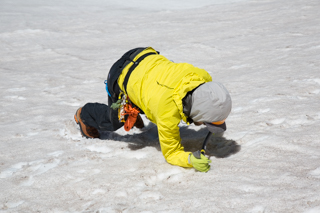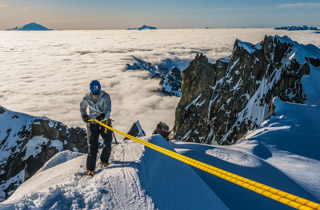Conquer What Holds You Back
Conquer What Holds You Back
Perhaps this is the year you’re committed to accomplishing a long-pursued goal. What’s held you back in the past? If you want different results, you may benefit from reframing your perspective. Are you ready and willing to critically examine your current levels of fitness to achieve better results?


Re-examining Challenges
We all face certain challenges in the mountains. They might include navigating boulder, scree, or talus slopes while carrying a heavy or uneven pack, paddling for hours with extended legs, or sleeping on uneven, hard ground. They could include crouching in awkward belay positions with exposed legs, or looking up for a long time as a partner climbs. The list is long, and all provide different stresses on the body.
Now try viewing these activities through the lens of training needs. What are the aerobic and anaerobic requirements of the trips you’d like to go on? How much upper, core, and lower body strength is needed? Do you have sufficient flexibility? How important is it to have full mobility in all your joints? Rather than letting weaknesses hold you back, focus on what areas you can develop to improve your experience.
Determine What's Lagging
The simplest way to find out where you’re struggling is to do a trial that simulates your target goal. For example, if you’re preparing to go backpacking, hiking, or climbing, walk on a trail akin to the one you’ll be traveling. To prepare for a kayaking trip, pull out your kayak and go paddling. If your goal includes rock climbing, explore the crags or a climbing gym with some friends. For any multi-day adventure, see how you feel doing your activity two days in a row without a rest day.
Afterward, assess how you feel. What was easy, and where did you have difficulty? Then, instead of simply doing more of what was easy, create a plan specifically designed to develop your weaknesses.
Shore Up Perceived Weaknesses
If your legs give out going uphill, focus on adding lower-body strength training exercises such as step-ups, squats, wall sits, static dips, or lunges. If your arms fail, add upper body strength training exercises including pull-ups or dead hangs, push-ups, and arm work.
If you can hike forever on flat ground but struggle as soon as you put on a backpack, add time on the trail with a loaded pack. If terrain causes difficulty, practice traversing over talus, scree, or uneven ground. And if you hate the thought of being stiff and tight while camping, add flexibility and mobility exercises to your training. If any parts of your body ache, consider adding stretches for the lower back, hips, and shoulders.
Finally, assess your gear. How do your feet feel? If they’re hurting, you may need new shoes, or simply more time to get used to the terrain. Did the pack give you any problems? Determine whether you’re loading it evenly, or if you need a better-fitted pack. Be sure to introduce any changes (like added pack weight or mileage) gradually to give your body time to adapt.

Make This Season Count
Always start your plan by thinking of your end goal. Identify the tasks you will need to perform. Think about the positions you’ll be in and for how long. Then, figure out how to include simulations of these activities in your training. By looking at your weaknesses as an opportunity to improve your skills and enhance your adventures, you can design an appropriate program that prepares you to achieve your goals.






